WEN 4276, BG4276 - 6 Inch Bench Grinder Manual
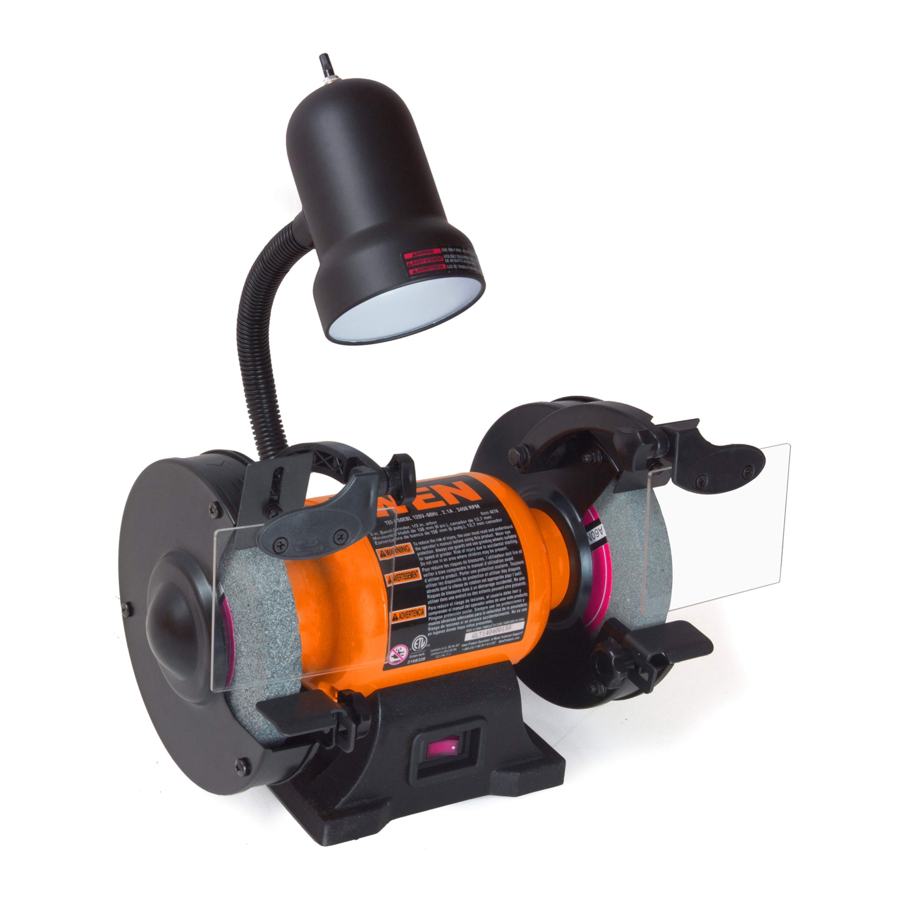

Read all safety warnings and all instructions. Failure to follow the warnings and instructions may result in electric shock, fire and/or serious injury.
Safety is a combination of common sense, staying alert and knowing how your item works. The term "power tool" in the warnings refers to your mains-operated (corded) power tool or battery-operated (cordless) power tool.
WORK AREA SAFETY
- Keep work area clean and well lit. Cluttered or dark areas invite accidents.
- Do not operate power tools in explosive atmospheres, such as in the presence of flammable liquids, gases or dust. Power tools create sparks which may ignite the dust or fumes.
- Keep children and bystanders away while operating a power tool. Distractions can cause you to lose control.
ELECTRICAL SAFETY
- Power tool plugs must match the outlet. Never modify the plug in any way. Do not use any adapter plugs with earthed (grounded) power tools. Unmodified plugs and matching outlets will reduce risk of electric shock.
- Avoid body contact with earthed or grounded surfaces such as pipes, radiators, ranges and refrigerators. There is an increased risk of electric shock if your body is earthed or grounded.
- Do not expose power tools to rain or wet conditions. Water entering a power tool will increase the risk of electric shock.
- Do not abuse the cord. Never use the cord for carrying, pulling or unplugging the power tool. Keep cord away from heat, oil, sharp edges or moving parts. Damaged or entangled cords increase the risk of electric shock.
- When operating a power tool outdoors, use an extension cord suitable for outdoor use. Use of a cord suitable for outdoor use reduces the risk of electric shock.
- If operating a power tool in a damp location is unavoidable, use a ground fault circuit interrupter (GFCI) protected supply. Use of a GFCI reduces the risk of electric shock.
PERSONAL SAFETY
- Stay alert, watch what you are doing and use common sense when operating a power tool. Do not use a power tool while you are tired or under the influence of drugs, alcohol or medication. A moment of inattention while operating power tools may result in serious personal injury.
- Use personal protective equipment. Always wear eye protection. Protective equipment such as a respiratory mask, non-skid safety shoes and hearing protection used for appropriate conditions will reduce the risk of personal injury.
- Prevent unintentional starting. Ensure the switch is in the off-position before connecting to power source and/or battery pack, picking up or carrying the tool. Carrying power tools with your finger on the switch or energizing power tools that have the switch on invites accidents.
- Remove any adjusting key or wrench before turning the power tool on. A wrench or a key left attached to a rotating part of the power tool may result in personal injury.
- Do not overreach. Keep proper footing and balance at all times. This enables better control of the power tool in unexpected situations.
- Dress properly. Do not wear loose clothing or jewelry. Keep your hair and clothing away from moving parts. Loose clothes, jewelry or long hair can be caught in moving parts.
- If devices are provided for the connection of dust extraction and collection facilities, ensure these are connected and properly used. Use of dust collection can reduce dust-related hazards.
POWER TOOL USE AND CARE
- Do not force the power tool. Use the correct power tool for your application. The correct power tool will do the job better and safer at the rate for which it was designed.
- Do not use the power tool if the switch does not turn it on and off. Any power tool that cannot be controlled with the switch is dangerous and must be repaired.
- Disconnect the plug from the power source and/or the battery pack from the power tool before making any adjustments, changing accessories, or storing power tools. Such preventive safety measures reduce the risk of starting the power tool accidentally.
- Store idle power tools out of the reach of children and do not allow persons unfamiliar with the power tool or these instructions to operate the power tool. Power tools are dangerous in the hands of untrained users.
- Maintain power tools. Check for misalignment or binding of moving parts, breakage of parts and any other condition that may affect the power tool's operation. If damaged, have the power tool repaired before use. Many accidents are caused by poorly maintained power tools.
- Keep cutting tools sharp and clean. Properly maintained cutting tools with sharp cutting edges are less likely to bind and are easier to control.
- Use the power tool, accessories and tool bits, etc. in accordance with these instructions, taking into account the working conditions and the work to be performed. Use of the power tool for operations different from those intended could result in a hazardous situation.
- Use clamps to secure your workpiece to a stable surface. Holding a workpiece by hand or using your body to support it may lead to loss of control.
- KEEP GUARDS IN PLACE and in working order.
SERVICE
- Have your power tool serviced by a qualified repair person using only identical replacement parts. This will ensure that the safety of the power tool is maintained.
CALIFORNIA PROPOSITION 65 WARNING
Some dust created by power sanding, sawing, grinding, drilling, and other construction activities may contain chemicals, including lead, known to the State of California to cause cancer, birth defects, or other reproductive harm. Wash hands after handling. Some examples of these chemicals are:
- Lead from lead-based paints.
- Crystalline silica from bricks, cement, and other masonry products.
- Arsenic and chromium from chemically treated lumber.
Your risk from these exposures varies depending on how often you do this type of work. To reduce your exposure to these chemicals, work in a well-ventilated area with approved safety equipment such as dust masks specially designed to filter out microscopic particles.
BENCH GRINDER SAFETY WARNINGS
Do not operate the power tool until you have read and understood the following instructions and the warning labels.
BENCH GRINDER SAFETY
- This bench grinder is designed for sharpening and honing cutting tools, using the appropriate accessories. Using the machine for any other purpose for which it is not designed may result in serious injuries, machine damage and voiding of the warranty.
- Grinding wheel safety:
- Only use grinding wheels rated for a speed higher than 3450 RPM (maximum RPM of the tool).
- Inspect wheels for cracks or fragments before starting the machine. Replace damaged wheels immediately. Never use a questionable grinding wheel, as the RPM of the machine can send broken wheel fragments flying at high speeds.
- Do not use a wheel that vibrates. If a wheel vibrates, it may be that the bearings of the shaft need replacing.
- Check that the grinding stone can rotate smoothly before starting the machine.
- The grinding wheel is for grinding. Never attempt to cut anything with the grinding wheel.
- The use of accessories or attachments not recommended by the manufacturer may result in a risk of personal injury.
Fire Hazard. Do not grind or polish magnesium or magnesium alloys.- Preventing accidental starting. Make sure the power switch is in the OFF position prior to plugging in the machine. Always make sure the power switch is in the OFF position and the machine is unplugged when doing any cleaning, adjustments, assembly, setup operations, or when not in use.
PERSONAL SAFETY
- Operate in a well ventilated area. Keep the floor area around the bench grinder level and free of slippery substances or other tripping hazards.
- Wear ANSI-approved safety goggles to protect your eyes from sparks and chips. Use hearing protection to protect yourself from hearing loss.
- DO NOT wear loose clothing or jewelry as they might get drawn in by the tool. Tie back long hair.
- People with pacemakers should consult their physician(s) before use. Electromagnetic fields in close proximity to pacemakers could cause pacemaker interference or pacemaker failure.
- Chips are harmful to your health. Use NIOSH-approved dust masks or other respiratory protection during operation and cleaning.
- Always turn off and unplug the bench grinder before making any adjustments or repair tasks. Never adjust the bench grinder or the workpiece while the tool is running.
PREPARING THE BENCH GRINDER
When transporting the bench grinder, carry it by the base. Never carry the device by its guards or its accessories.
- Examine the bench grinder for any damaged or missing parts. Replace or repair damaged parts before operation. Periodically check that all nuts, bolts and other fasteners are properly tightened.
- Do not operate this tool until it is completely assembled and installed according to the instructions. Make sure all adjustments are correct and all connections are tight. Keep all guards in place.
DURING OPERATION
- Never start the machine with any load already applied to either grinding wheel. Stand to the side of the bench grinder during start-up. Switch it ON and let the bench grinder reach full speed for roughly one minute to warm up the wheel and to ensure proper operation.
- Never grind on a cold wheel. Run the bench grinder for one full minute before applying the workpiece. Cold wheels have an increased likelihood of chipping during operation.
- Only grind on the face of the grinding wheel. Do not grind on the side of the wheel.
- Keep clear of moving parts. Keep arms, hands and other vital appendages away from the grinding and honing wheel. Do not reach behind or beneath the rotating wheel. Avoid awkward operation and hand positions. An accident could easily send the operator's hand into the wheel.
- If you are interrupted when operating the bench grinder, complete the process and switch the bench grinder off before looking up.
- Always hold the workpiece firmly against the tool rest.
- Never attempt to cut anything with the grinding wheel.
- Do not use the bench grinder unless all guards are in place. Do not operate with any guard disabled, damaged, or removed. Moving guards must move freely and close instantly.
- Disconnect the power source and allow the wheels to come to a complete stop before making any adjustments to either the machine or the grinding wheels.
- Clean the machine thoroughly when changing material types in workpieces. Combining certain materials can increase the chances of an explosion or fire hazard.
- Should any component of your bench grinder be missing/damaged or fail in any way, shut off the switch and remove the plug from power supply outlet. Have a certified technician replace the missing, damaged, or failed parts using only identical replacement parts before resuming operation.
ELECTRICAL INFORMATION
GROUNDING INSTRUCTIONS
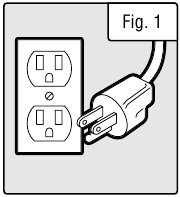
In the event of a malfunction or breakdown, grounding provides the path of least resistance for an electric current and reduces the risk of electric shock. This tool is equipped with an electric cord that has an equipment grounding conductor and a grounding plug. The plug MUST be plugged into a matching outlet that is properly installed and grounded in accordance with ALL local codes and ordinances.
- Do not modify the plug provided. If it will not fit the outlet, have the proper outlet installed by a licensed electrician.
- Improper connection of the equipment grounding conductor can result in electric shock. The conductor with the green insulation (with or without yellow stripes) is the equipment grounding conductor. If repair or replacement of the electric cord or plug is necessary, DO NOT connect the equipment grounding conductor to a live terminal.
- Check with a licensed electrician or service personnel if you do not completely understand the grounding instructions or whether the tool is properly grounded.
- Use only three-wire extension cords that have three-pronged plugs and outlets that accept the tool's plug. Repair or replace a damaged or worn cord immediately.
In all cases, make certain the outlet in question is properly grounded. If you are not sure, have a licensed electrician check the outlet.
GUIDELINES AND RECOMMENDATIONS FOR EXTENSION CORDS
When using an extension cord, be sure to use one heavy enough to carry the current your product will draw. An undersized cord will cause a drop in line voltage resulting in loss of power and overheating. The table below shows the correct size to be used according to cord length and ampere rating. When in doubt, use a heavier cord. The smaller the gauge number, the heavier the cord.
| AMPERAGE | REQUIRED GAUGE FOR EXTENSION CORDS |
| 25 ft. | 50 ft. | 100 ft. | 150 ft. |
| 2.1A | 18 gauge | 16 gauge | 16 gauge | 14 gauge |
- Examine extension cord before use. Make sure your extension cord is properly wired and in good condition. Always replace a damaged extension cord or have it repaired by a qualified person before using it.
- Do not abuse extension cord. Do not pull on cord to disconnect from receptacle; always disconnect by pulling on plug. Disconnect the extension cord from the receptacle before disconnecting the product from the extension cord. Protect your extension cords from sharp objects, excessive heat and damp/wet areas.
- Use a separate electrical circuit for your tool. This circuit must not be less than a 12-gauge wire and should be protected with a 15A time-delayed fuse. Before connecting the motor to the power line, make sure the switch is in the OFF position and the electric current is rated the same as the current stamped on the motor nameplate. Running at a lower voltage will damage the motor.
UNPACKING & PACKING LIST
Do not plug in or turn on the tool until it is fully assembled according to the instructions. Failure to follow the safety instructions may result in serious personal injury.
UNPACKING
With the help of a friend or trustworthy foe, carefully remove the Bench Grinder from the packaging. Make sure to take out all contents and accessories. Do not discard the packaging until everything is removed. Check the packing list below to make sure you have all of the parts and accessories. If any part is missing or broken, please contact our customer service at 1-800-232-1195 (M-F 8-5 CST), or email techsupport@wenproducts.com.
PACKING LIST
- Eye Shield Assembly x2
- Eye Shield Arm x2
- Locking Knob M5 x2
- Tool Rest x2
- Lock Washer 6 x2
- Flat Washer 6 x2
- Carriage Head Screw M6x14 x2
- Tool Rest Knob M6 x2
- Hex Head Bolt M6x30 x2
- Spark Deflector x2
- Screw, Flat Washer, Spring Washer Kit x2
KNOW YOUR BENCH GRINDER
TOOL PURPOSE
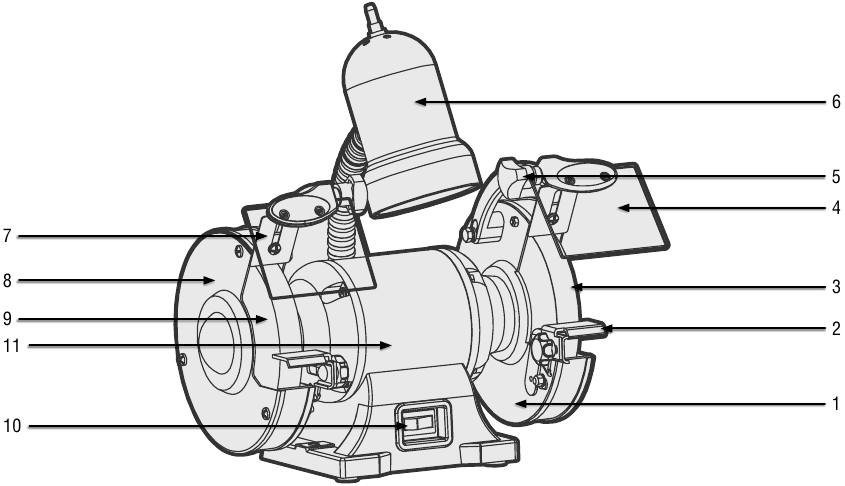
Sharpen bits, drill bits, chisels, gouges, and other cutting tools all with your WEN Bench Grinder. Refer to the following diagrams to become familiarized with all the parts and controls of your bench grinder. The components will be referred to later in the manual for assembly and operation instructions.
- INNER WHEEL GUARD - Covers the grinding wheels and protects against accidental contact.
- TOOL RESTS - Used to support the workpiece.
- 36-GRIT GRINDING WHEEL - Used to remove heavy material from the workpiece.
- EYESHIELD - Protective see-through shields to prevent any loose debris from contacting the operator.
- LOCKING KNOB - Lock the eyeshield in position.
- FLEXIBLE WORK LIGHT - Provides light to the operator during grinding operations.
- SPARK DEFLECTOR - Prevents hot sparks and debris from contacting the operator.
- WHEEL COVER - Covers the grinding wheels and provides quick access for routine maintenance.
- 60-GRIT GRINDING WHEEL - Used to remove light material from the workpiece.
- ON/OFF SWITCH - Used to turn ON and turn OFF the bench grinder.
- MOTOR HOUSING - Contains the electrical motor.
ASSEMBLY & ADJUSTMENTS
To avoid injury from unexpected starting or electrical shock, do not plug the power cord into a source of power during unpacking and assembly. This cord must remain unplugged whenever you are adjusting/assembling the grinder.
TOOL REST ASSEMBLY
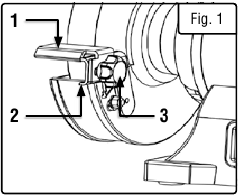
- Place the left tool rest (Fig. 1 - 1) over the tool rest bracket (Fig. 1 - 2).
- Align the left tool rest with the hole on the bracket and slide the carriage head screw through from the left side.
- Screw the tool rest knob into place (Fig. 1 - 3)
- Adjust the tool rest within 1/16 in. of the grinding wheel. To adjust this distance, loosen the knob and move the tool rest.
- Assemble the right tool rest in a similar manner.
SPARK DEFLECTOR AND EYESHIELD ASSEMBLY
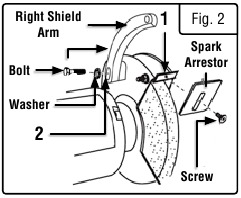

- Place the spark deflector against the right wheel guard and secure into place using a screw (Fig. 2 - 1). Adjust the spark deflector within 1/16" (0.0625") of the right grinding wheel and tighten the screw.
- Attach right shield arm to the right wheel guard using a bolt and washer and secure into place (Fig. 2 - 2).
- Attach the right eye shield to the right shield arm and tighten the locking knob into place (Fig. 3).
- Attach spark deflector and eye shield to the left guard in a similar manner.
WORK LIGHT
The bench grinder is provided with a flexible work light to assist in visibility of the workpiece. The bench grinder is NOT provided with a light bulb for the flexible work light. To reduce the risk of fire, use a 120V 40W (or less) track light bulb, type R20, medium base or equivalent (not included). DO NOT use a light bulb that extends past the end of the light housing.
The flexible work light housing will remain hot for a few minutes after turning it OFF. Avoid contact with housing until it cools.
MOUNTING TO THE WORK SURFACE
The bench grinder should be firmly attached to a reliable work surface using mounting hardware (not included) through the base of the grinder's mounting holes. This will prevent the bench grinder from vibration, walking or tipping during operation.
NOTE: This bench grinder is compatible with the WEN 4288 Cast Iron Bench Grinder Pedestal Stand.
- Prepare 1/4 in. bolts, flat washers, lock washers and hex nuts (not included). The bolt length should be 1-1/2 in. longer than the thickness of the workbench.
- Locate and mark the holes where the grinder is to be mounted onto the work surface.
NOTE: If mounting to a work bench, drill four 3/8 in. diameter holes through the workbench.
- Place the bench grinder onto the workbench, aligning holes in base with holes in the workbench.
- Insert four 1/4 in. diameter bolts and washers and attach with nuts securely.
Always make sure your bench grinder is securely mounted to a workbench. Failure to do so could result in an accident resulting in possible serious personal injury.
OPERATION
Keep all bystanders a safe distance away from the tool.
BASIC OPERATION
- Your bench grinder has a medium wheel (60 grit) for medium material removal and general purpose grinding, and a coarse wheel (36 grit) for fast material removal.
- To operate the bench grinder, always wear safety glasses and turn the tool on while standing at the side and not in front of the grinder. Allow it to reach full speed before grinding.
- Hold the work piece firmly against the tool rest. Hold very small pieces with pliers or other suitable clamps.
- Feed the work piece smoothly and evenly into the grinding wheel.
- Move the work piece slowly and avoid jamming the work piece against the wheel. If the wheel tends to slow down from excessive force, you should occasionally release the pressure to let the wheel return to full speed.
- Grind only on the face of the grinding wheel and never the side of it.
Prolonged grinding will cause most materials to become hot. Use care when handling such materials.
SHARPENING SCISSORS
If possible, take the scissors apart to make the sharpening operation easier and safer. Remove material only from the outside surface and work from the heavy end of the blade toward the tip.
SHARPENING KNIVES
Remove metal from both faces of most knives, working from the heavy end of the blade toward the tip.
SHARPENING SCREWDRIVERS
The end of a properly sharpened screwdriver will be a perfect rectangle, absolutely flat and perpendicular to the center line of the shank. The two sides and two faces will taper outward from the edge of the shoulder or shank. They should be flat with intersecting faces perpendicular. Hold each face of the screwdriver against the wheel to true it up, and then ease the end straight into the stone to grind it true.
LAWN MOWER BLADES
Lawn mower blades are usually sharpened on only one side and dressed up slightly on the other. After sharpening, be sure to balance blade by removing additional material from heavy end. There are a number of inexpensive cone balancers on the market for this purpose. Unbalanced blades can cause serious crank shaft damage to your lawn mower. Always remove spark plug wires from the mower before servicing the blades to prevent accidental starting.
MAINTENANCE
For your own safety, turn the switch OFF and remove the plug from the electrical outlet before adjusting or performing maintenance or lubrication work on the grinder.
Before using, check to make sure parts are not damaged, missing, or worn. Check for alignment of moving parts, binding of moving parts, improper mounting, or any other conditions that may affect the grinder's operation. If any of these conditions exist, do not use until parts are replaced or the grinder is properly repaired. Frequently blow or vacuum dust from all surfaces and the motor housing.
Any attempt to repair or replace electrical parts on this tool may be hazardous. Repairs should be done by a qualified service technician only.
GENERAL CLEANING AND MAINTENANCE
- Regularly check the tool and use a soft brush to remove accumulated dust. Wear safety goggles to protect your eyes while cleaning.
- If the body of the grinder needs cleaning, wipe down with soft damp cloth. A mild detergent can be used. Do not use alcohol, petrol, or other similar cleaning agents. Do not make contact with grinding wheels with any damp cloth.
- Always make sure the eye shields are transparent and not blocking the view of the grinding wheel.
- In normal use, grinding wheels may become cracked, grooved, rounded at the edges, chipped, out of alignment or loaded with foreign material. Cracked wheels should be replaced IMMEDIATELY. While any of the other conditions can be remedied, new wheels sometimes require dressing to make them round.
- If you must replace a wheel be sure to obtain one with a safe rated speed at least as high as the "NO LOAD" RPM marked on your grinder's nameplate. Replacement wheels must have a 6 inch diameter, a matching arbor size and should be a maximum of 3/4 inch wide. Always check new wheels for cracks. Be sure the tool is unplugged before attempting repairs and maintenance.
Never use caustic agents to clean the plastic parts of the tool. Water must never come into contact with the grinder. The use of any other accessories is not recommended and may result in serious injury.
CHANGING THE GRINDING WHEEL
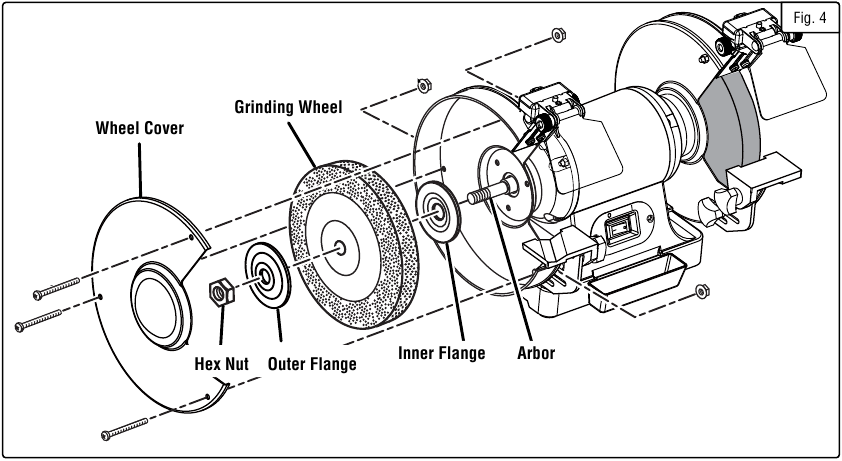
In normal use, grinding wheels may become cracked, grooved, rounded at the edges, chipped, out of true or loaded with foreign material. Grinding wheels should be inspected before each use. Cracked wheels should be replaced immediately. Any of the other conditions can be remedied with a dressing tool (not included).
To replace a grinding wheel:
- Ensure that the machine is powered off and unplugged.
- Using a Phillips head screwdriver and adjustable wrench, remove the three bolts and nuts from the wheel cover. Repeat for the other side.
- Using two 19 mm wrenches, loosen the arbor hex nut found on the outside edge of the grinding wheel. The left side hex nut is loosened by using a clockwise wrench rotation while the right side hex nut is loosened with a counterclockwise rotation. If you are having difficulty with the two-wrench method, you may try holding one wheel while loosening the nut. Wear gloves if you decide to use this method to avoid scraping your hand or fingers. Remove the arbor hex nut and outer wheel flange.
- Replace the grinding wheel with a new grinding wheel that has a speed rating higher than 3450 RPM. The outer diameter of the wheel should be 6 inches and the arbor size should be 1/2 of an inch. Do not remove labels from the grinding wheels.
- Once the wheel has been replaced, re-attach the outer flange and the arbor hex nut.
POWER CORD REPLACEMENT
If replacement of the power supply cord is necessary, this must be done by an authorized service center in order to avoid a safety hazard.
STORAGE
Store the bench grinder and the grinding wheels to prevent them from the potential hazards of moisture, containments, and other damage.
NEED HELP? CONTACT US!
Have product questions? Need technical support? Please feel free to contact us:
1-800-232-1195 (M-F 8AM-5PM CST)
TECHSUPPORT@WENPRODUCTS.COM
For replacement parts and the most up-to-date instruction manuals, visit WENPRODUCTS.COM

Documents / Resources
References

- WEN - Shop Generators, Woodworking Tools, and Power Tools — WEN Products
Download manual
Here you can download full pdf version of manual, it may contain additional safety instructions, warranty information, FCC rules, etc.
Need Assistance?
Do you have a question about the 4276 that isn't answered in the manual? Leave your question here.
Thank you! Your question has been received!











![]()